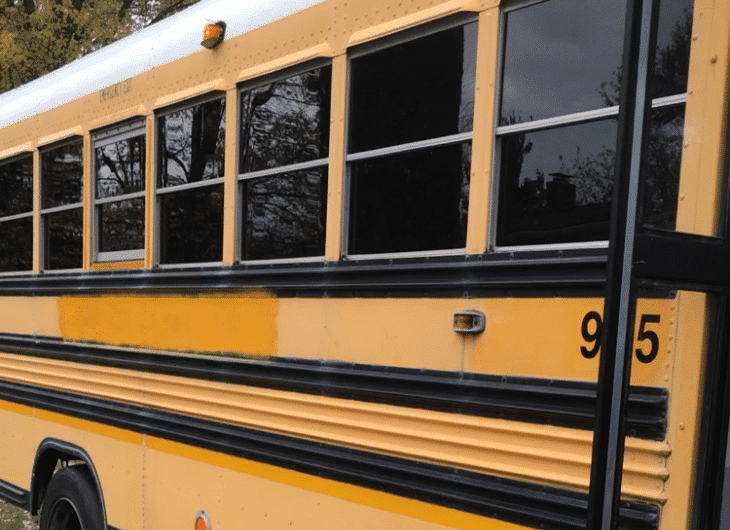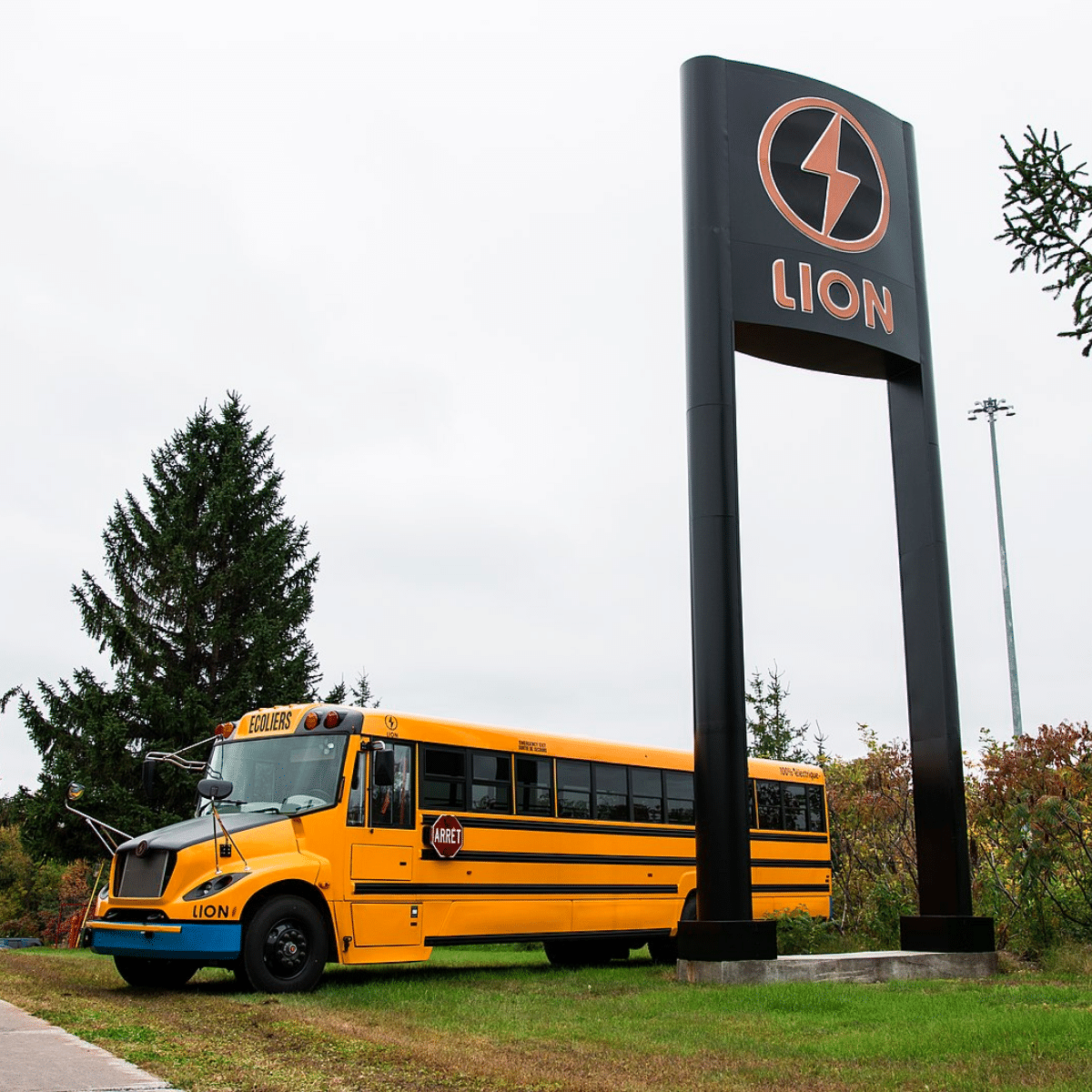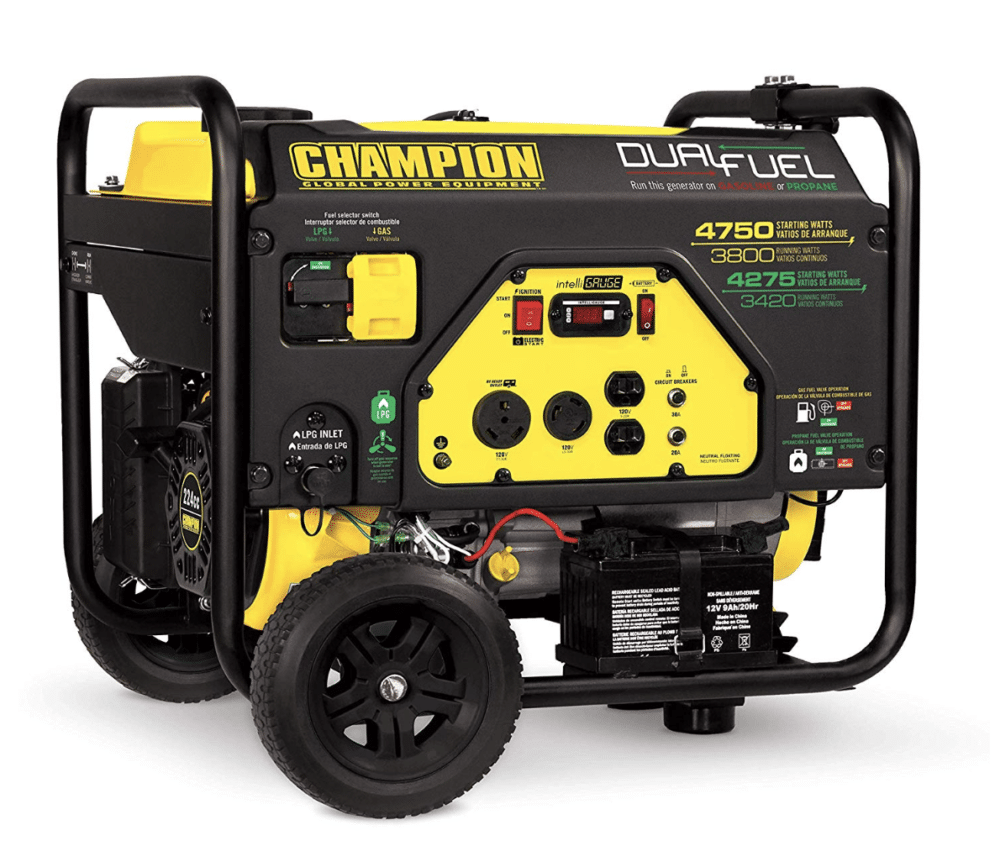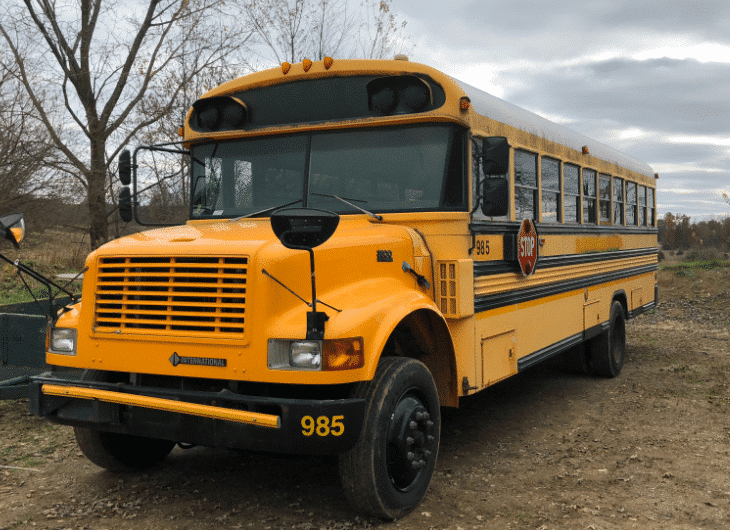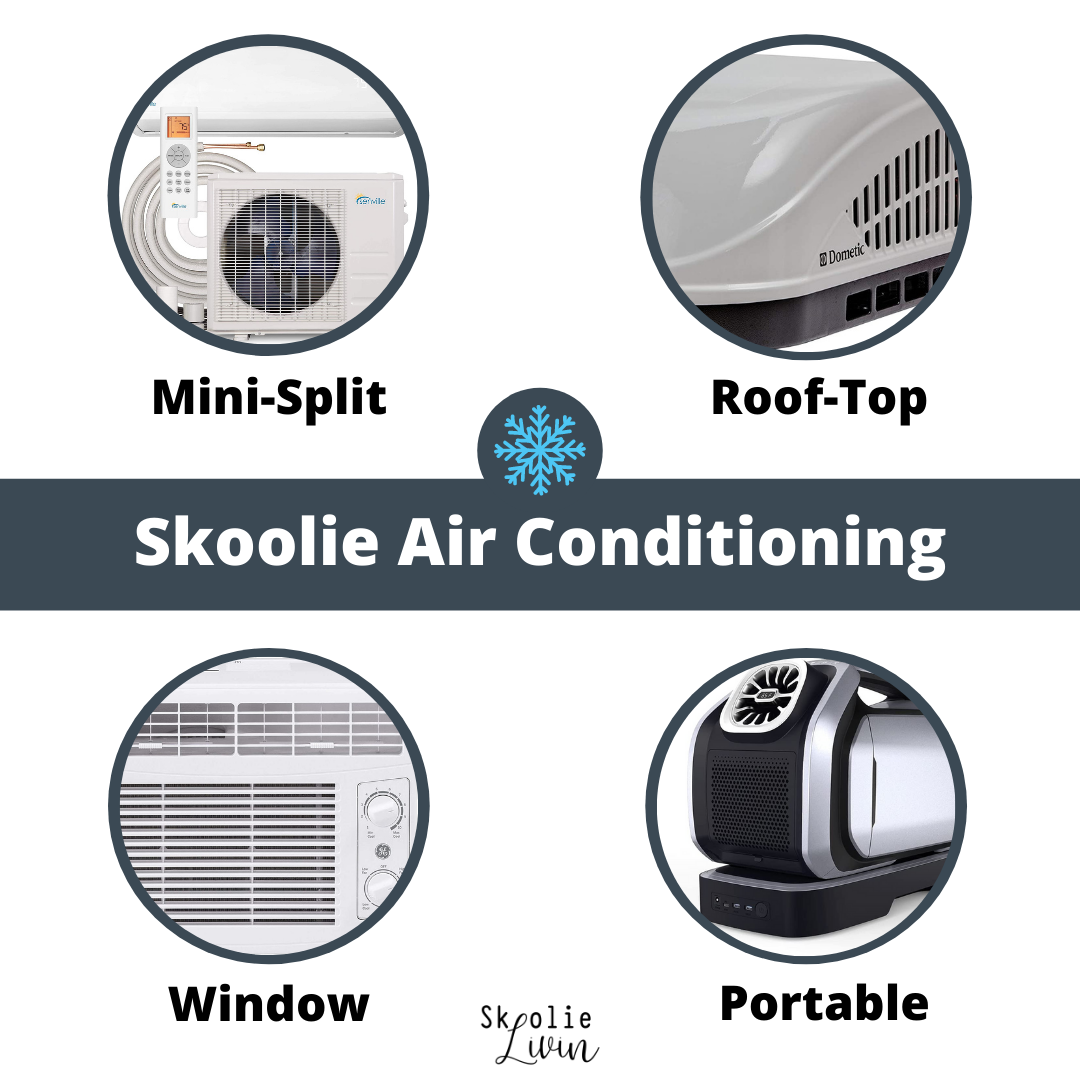
There are different skoolie air conditioning options that are best for specific scenarios, from the size of your skoolie to your travel desires and your skoolie’s power capabilities.
Our goal with this skoolie air conditioning guide is to help you:
- Determine if you need air conditioning in your school bus conversion.
- Review the types of air conditioners for skoolies.
- Decide on what is the best air conditioner for a bus conversion based on your situation.
Like most things in a skoolie build, there is no cookie-cutter solution for cooling a skoolie. We will all stay and travel to different locations with different climates.
This list of the best skoolie AC options will help with reviewing the overall features and capabilities/requirements to use them off-grid.
We will go through the following options:
- RV Rooftop Air Conditioners
- Traditional Window AC Units
- Mini-Split Air Conditioner
- Portable Air Conditioners
For each option, we will review the power requirements, when and how to run them on- or off-grid, and good product options for each category based on our extensive research on this topic.
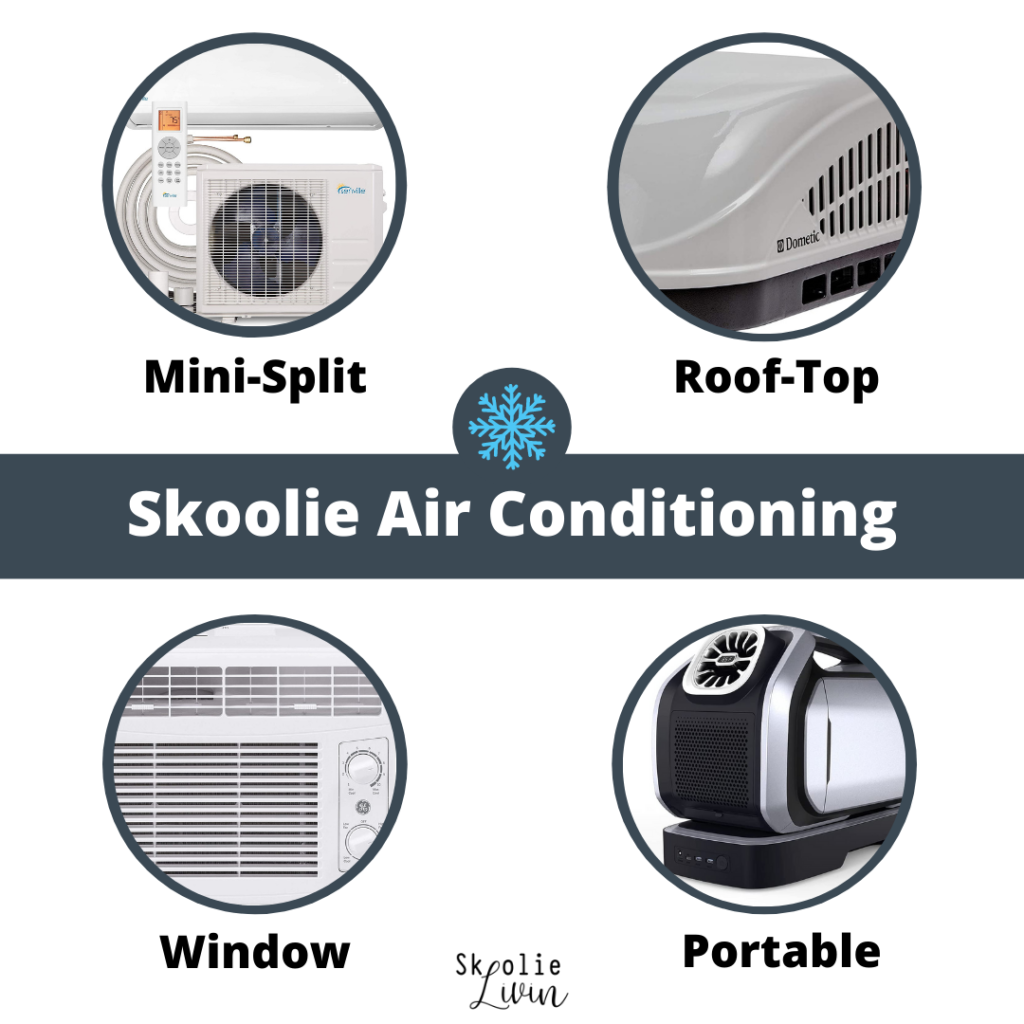
Special Note: This article does have affiliate links. If you click a link and happen to make a purchase, we may receive a small commission at no cost to you. Thanks for your support – this commission helps us to continue serving the skoolie community!
Is Air Conditioning Needed In a Skoolie?
Yes, having air conditioning in a skoolie is worth it! A school bus conversion will get very warm or hot when it is hot and sunny outside no matter how well the floor, ceiling, and walls were insulated.
First, making room for an air conditioner and having it installed in your skoolie during the build stage is the best approach. This is the most convenient way to ensure cooling your skoolie with an AC is an option.
Sarah and I highly recommend making room for and installing air conditioning during the build stage, since adding this later on when the build is nearing completion or already finished can be a challenge.
A skoolie will typically get as hot as it is outside if you are not proactively working to lower the temperature. In more mild weather you can circulate and vent the air with open windows and a good vent fan to make it feel cooler. However, having a skoolie air conditioner working to actually lower the temperature in your skoolie is the best option in higher temperatures and humidity.
Typically, you will want an air conditioner in your skoolie if you plan on being in hot, sunny weather from around 80° F and above. An air conditioner in a skoolie can also help make being inside the skoolie more comfortable in more humid locations.
Best Skoolie Air Conditioning Options

There is not a cookie-cutter answer to what is the best school bus conversion air conditioning option.
Your specific situation, the size of your skoolie, and where you plan to live/travel all factor into this decision.
To ease into this, let me first explain how Sarah and I selected our air conditioning option.
First, when Sarah and I first started our skoolie build we sort of planned on traveling wherever and whenever. We did not want to worry about the weather, so we took our skoolie HVAC very seriously.
(Side Note: Make sure to check out our 4 ways we heat our skoolie even in Wisconsin winters in the Skoolie Heat Options article.)
Luckily, my father owns a heating and cooling business that has had 4 generations involved in it – so we had the opportunity to pick his brain and consult with him on all of the skoolie HVAC options.
When we first bought a bus and parked it in my parent’s driveway, it was November. We were mostly worried about skoolie heating options. Then, as summer of 2019 rolled around, the summer weather became the hot topic of our discussion and skoolie air conditioning went from being a thought to a “we need it right now” necessity!
We had some initial concerns about power, but after thinking about it we decided to worry about power later. In the next section, we’ll explain why.
Skoolie Air Conditioning Power Consumption
| Air Conditioner Size (BTU) | Power Consumption (Watts/hr) |
| How many watts is a 5000 BTU air conditioner? | 400 – 625 W |
| How many watts is a 6000 BTU air conditioner? | 500 – 750 W |
| How many watts is an 8000 BTU air conditioner? | 650 – 1000 W |
| How many watts is a 10000 BTU air conditioner? | 800 – 1250 W |
| How many watts is a 12000 BTU air conditioner? | 1000 – 1500 W |
| How many watts is a 15000 BTU air conditioner? | 1250 – 1875 W |
| How many watts is an 18000 BTU air conditioner? | 1500 – 2250 W |
Powering Skoolie Air Conditioning On- & Off-Grid
The largest concern when it comes to selecting a skoolie AC option is powering an air conditioner in a skoolie.
The two scenarios to differentiate when selecting an air conditioner for your skoolie are if you plan on:
- Running the AC only when hooked up to shore power
- Having enough power to run the skoolie air conditioning on solar when spending time off-grid with shore power when available
This deserves an article of it’s own, but here are the basics.
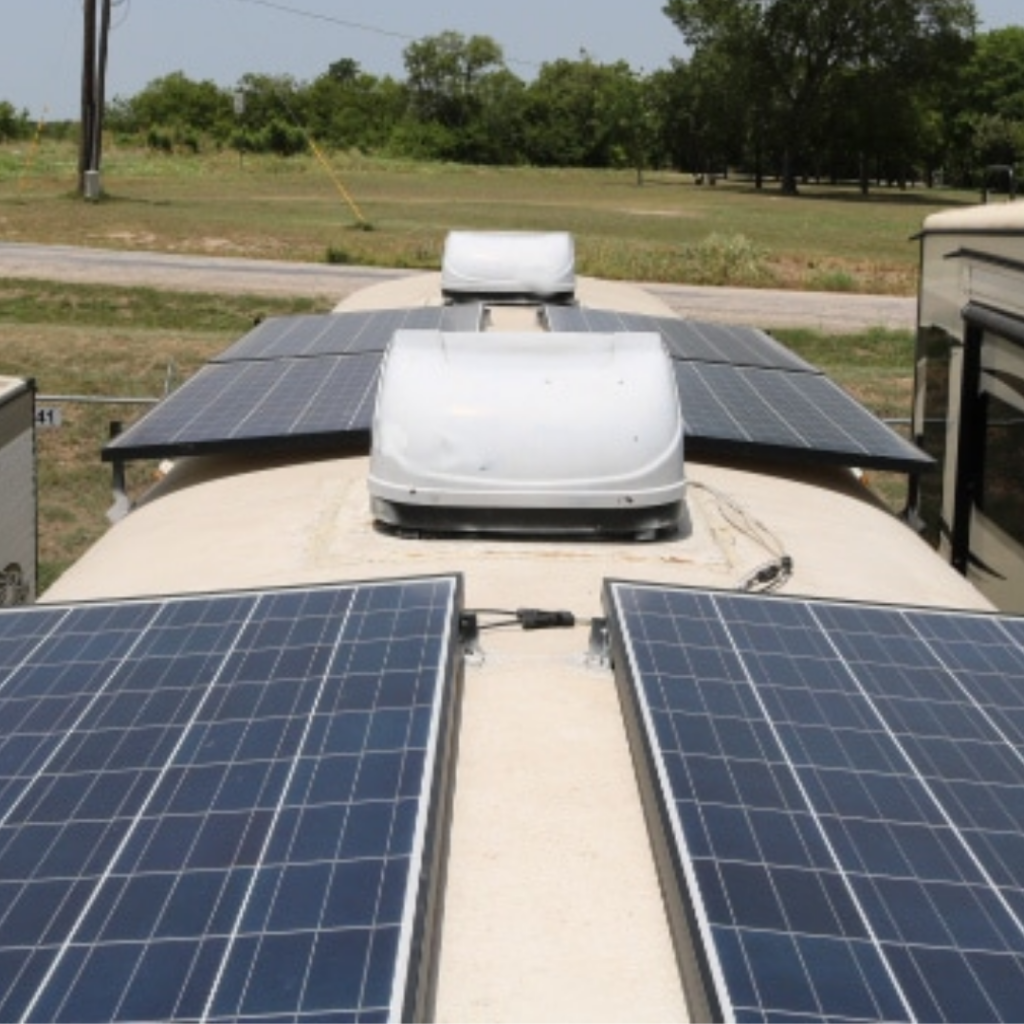
Run Only on Shore Power
If you plan to run the air conditioner only when connected to shore power, then by all means install a larger 12,000 to 18,000 BTU mini-split air conditioner if you have the room!
Your skoolie power requirement really does not matter in this case since you will be running the AC unit of shore power. If you plan to run 208V-230V for other appliances, this may be an option for you. However, most skoolie air conditioners people use when running on shore power are 110V-120V units.
Make sure you have the correct wiring (110V-120V or 208V-230V) and correct shore power amp hook-up (30 amp/50 amp) to be able to run the unit properly.
Shore Power/Off-Grid Capable
The easiest and cheapest way to run an air conditioner off-grid is to have a larger 110V-120V inverter.
If you have more money, you could purchase a 12V or 24V air conditioner specifically built for off-grid applications, but these can cost $2,000+. I detail out a few of these options later in this guide.
However, the cheaper option would be to add some solar panels to the roof, buy a larger or an additional power inverter, and use a regular 110V – 120V air conditioning unit.
When you are off-grid, your air conditioner will need to run off your inverter if it is 110V-120V. Because of this, you want to make sure your inverter is sized appropriately for the inverter.
The next concern is the amount of solar on the roof.
Solar Needed to Run AC Without Many Restrictions:
(All Day)
Solar panel array with at least 50-100% over what your air conditioner consumes.
This is a general rule to be able to sustain running your air conditioner without much need for watching your battery bank on a typical sunny day with a properly sized battery bank.
Examples:
600W – 800W solar array for 400W Air Conditioner
900W – 1200W solar array for 650W Air Conditioner
Solar Needed to Run AC During Peak Sun:
(5-7 Hours/Day)
Solar panel array with at least 20-40% over what your air conditioner consumes.

This is a general rule to be able to sustain running your air conditioner during the peak sun/temperatures with a properly sized battery bank.
In this scenario, I would keep an eye on your battery bank to make sure you were still charging up the bank to have battery capacity for the night/next day(s) if it will be cloudy/overcast.
If you have an oversized battery bank, you could run your AC on and off through the night with this scenario. Just keep in mind how much your solar array can handle and how much it will be able to recharge the batteries if you are also keeping your AC on throughout the day.
Examples:
500W – 600W solar array for 400W Air Conditioner
800W – 1000W solar array for 600W Air Conditioner
These are just some general rules to make sure your solar panels were capable of not only producing enough power for your air conditioner to run during the day, but also enough to recharge your battery bank enough to get through the night.
Obviously, keep an eye on the weather the next couple of days in either scenario as you will want your batteries fully charged and conserve energy if there will not be good sun for a few days.
Which air conditioners are good for an off-grid skoolie?
For each of the air conditioner options, we will go through if they are good for off-grid use. If they are, I will mention the battery bank and solar array size I would personally go with to run them for different durations of time each day.
Best Skoolie Air Conditioning Options
Now we are going to go through the following options:
- RV Rooftop Air Conditioners
- Traditional Window AC Units
- Mini-Split Air Conditioner
- Portable Air Conditioners
Let’s jump right in!
RV Rooftop Air Conditioners
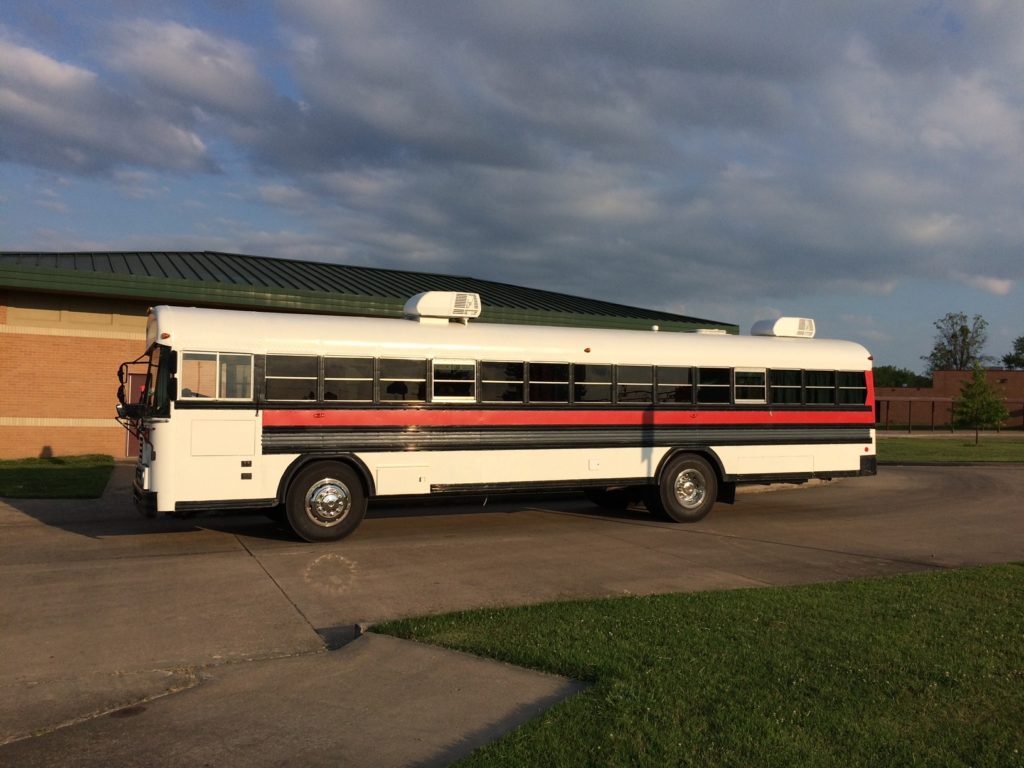
First up is installing an RV rooftop air conditioner in a skoolie.
Most of the common commercial units from Coleman, Dometic, Furion, and RecPro are all high output air conditioners using 110-120V power. They either require a shore power connection or an inverter with enough battery bank/solar to power to run off-grid.
Almost all rooftop RV air conditioners range from 11,000 to 15,000 BTU using 1,300 t0 2,300 watts.
RV Rooftop AC on Shore Power
These are great units if you plan on being connected to shore power! Since you’ll be connected to the grid, the power consumption really doesn’t matter much – unless you have to pay separately for electricity consumption and want to limit that bill.
If I had planned to only use this unit when on shore power, I would probably install the largest unit I could afford. However, if you also plan to be off-grid using the unit, I would continue reading…
RV Rooftop AC Off-Grid
For off-grid purposes, I would personally go with an 11,000 BTU model as these will consume less power than larger 13K and 15K BTU models.
Unit Power Requirements
With an 11,000 BTU air conditioner, you are looking at consuming around 1,300-1,500 watts per hour (10-12.5 amps @ 120V), with a startup draw of around 3,000 watts (25 amps @ 120).
Solar + Battery Requirements
I would have a massive solar array (1,600W+) and a decent-sized power bank (800 ah+), with a shore connection when possible to run these.
When to Run
I would only run these during the day while the sun was producing power on the solar panels. I would monitor your solar and battery power consistently to make sure your solar was producing enough power to run the air conditioner, as even this small unit will be consuming 50 amps per hour @ 24V or 100 amps per hour @ 12V.
I would probably not run the unit at night since it would consume a ton of power from your battery bank unless you plan on running a generator for extra power at night.
I would personally go with a smaller window air conditioner installed in the back of the bus to run at night that consumes less power, which we will get into next.
Best Skoolie RV Roof-top Air Conditioner (On-Grid Only)
Best Skoolie RV Roof-top Air Conditioner (On-Grid / Off-Grid)
Traditional Window AC Units
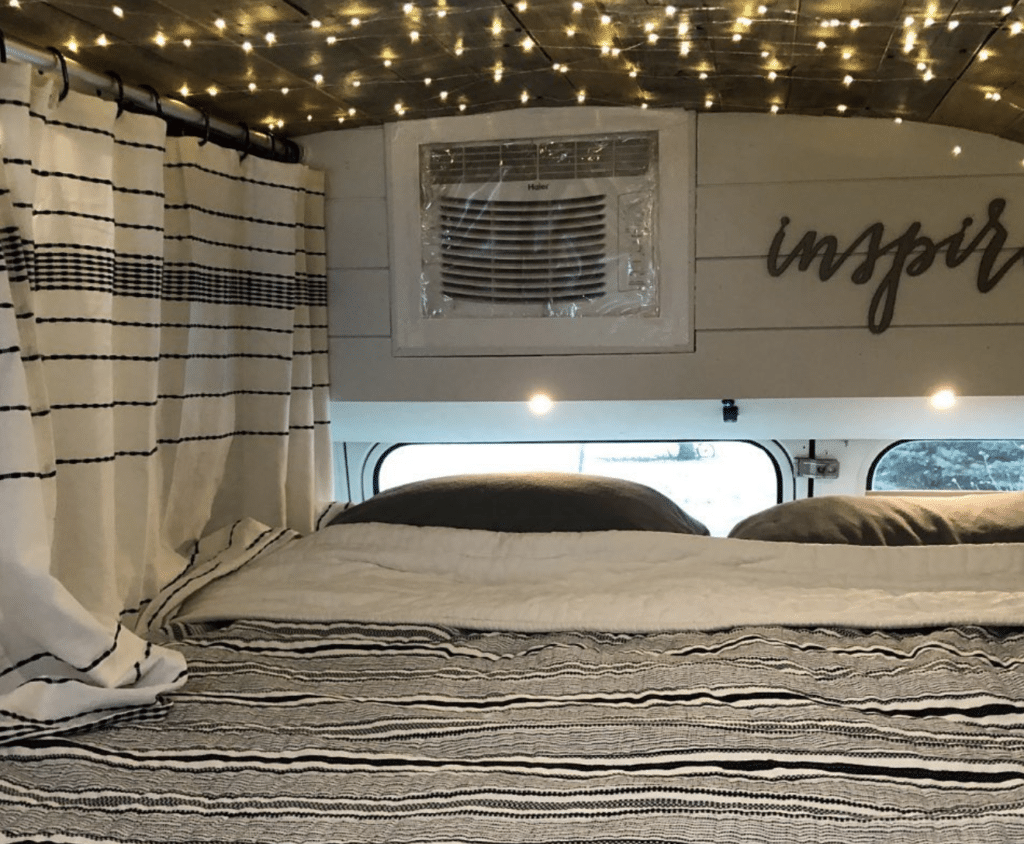
Window air conditioners are only good if you want to get something that draws less power than a RV rooftop AC unit. These would be the 5,000 BTU window air conditioners to 8,000 BTU window air conditioners.
We installed a 5,000 BTU air conditioner that pulls around 500 watts @ 120V, so it is about 1/3 the power draw of an 11,000 BTU rooftop air conditioner.
Skoolie Window AC on Shore Power
Like roof-top air conditioners, these are very convenient for running on a shore power hookup without much issue.
Depending on the size of the window air conditioner installed, you may actually save some money if you need to pay separately for the electrical hookup.
Skoolie Window AC Off-Grid
The lower power draw of window air conditioners will allow you to run the air conditioner off-grid with less solar requirements during the day.
These can also make it more convenient to run in the evening or at night, even if you use your power bank since the power draw is much lower than a rooftop unit. However, a larger power bank would still be required to ensure you do not consume all of your power before the sun rises.
This of course is based on you installing a smaller BTU-rated air conditioner in your skoolie compared to an 11K+ RV rooftop air conditioner.
Unit Power Requirements
As I previously mentioned, our 5,000 BTU window air conditioner, you are looking at consuming around 1,300-1,500 watts per hour (10-12.5 amps @ 120V), with a startup draw of around 3,000 watts (25 amps @ 120).
Keep in mind that the higher the BTU, the more watts per hour it will consume and the higher the initial startup power draw will be.
Solar + Battery Requirements
If you had a moderately sized power bank (400 Ah+ AGM or 200 Ah+ LiFePO4 Lithium), I would focus more on the solar array being able to produce 30-40% more than the window air conditioner will consume. This will allow you to use the window AC without worrying that you will eat too much into your battery capacity.
When to Run
To be safe, I would recommend running a window air conditioner in a skoolie off-grid only during the day in full sun with a system that is no less than 200 Ah of usable battery capacity (400 Ah+ of AGM or 200 Ah+ of LiFePO4 Lithium) with as big of a solar panel array as possible. At least 30-40% over the watt size of the window air conditioner. More is better.
Again, be sure to monitor your solar and battery power consistently to make sure your solar was producing enough power to run the air conditioner.
If you invest in a larger battery bank, you could run the unit sporadically throughout night without issue as long as you only consume the power you are able to replace within the next day or two from the solar or other charging methods.
Best Small Skoolie Window Air Conditioner
(Cheap & Low Power/BTU)
Best Large Skoolie Window Air Conditioner
(High Power/BTU)
Mini-Split Air Conditioner
The standard home and apartment-style mini-split air conditioners run on 110/120V or 220/240V and can range from 9,000 to 30,000 BTU, or higher.
Mini-split air conditioners in a skoolie are great for full-size skoolies that can support a massive solar power system or for skoolies planning to often be connected to shore power.
What Size Mini Split to Install in a Skoolie?
The size of the mini-split air conditioner to install in a skoolie depends on:
- The size of the skoolie
- The skoolie layout design
- The space available for the unit
- The type of power available (110-120V or 220-240V)
- The desire for on-grid only or on-/off-grid use
The last two points (#3 & #4) are probably the largest concerns when initially deciding what mini-split AC to go with. In most situations, you will probably want to stick with a 110-120V option as the only other reason to install 220-240V system in your skoolie is to potentially have a washer/dryer (although these also come in 110-120V options). Keeping everything to 110-120V makes building the skoolie much easier, but this will limit most mini-split air conditioner options to 16,000 BTU or less.
Mini-Split Skoolie AC on Shore Power
If you plan to be connected to shore power at most places you park, installing a mini-split in a skoolie is most likely your best option. In this case, you can pretty much go with any BTU size and voltage mini-split air conditioner that fits your skoolie’s size and layout requirements.
Off-Grid Skoolie Mini-Split Air Conditioner
Like the roof-top and window air conditioners we previously went through, I would personally go with a smaller mini-split air conditioner for an off-grid capable skoolie setup that can run off your standard 110-120V inverter.
The go-to system is 9,000 BTU that will pull around 700 – 900 watts/hour.
Going up to a 12,000 BTU mini-split air conditioner will pull around 1,000 – 1,500 watts/hour.
Keep in mind that these will need to run off your inverter, so you will want to properly size the inverter.
Solar + Battery Requirements
If you have a skoolie line very large solar panel array on a full-size skoolie with a massive lithium battery bank, then you could probably run a mini-split air conditioner sporadically during the evening and night. Otherwise, a mini-split will most likely only be running during the day when your solar panel array is producing power. You will want to focus on having a large enough panel array to support the air conditioner using the rules outlined earlier in this article.
RV Roof-Top VS Mini-Split Air Conditioner
A 9,000 BTU skoolie mini-split air conditioner will consume less power than an RV roof-top air conditioner. A mini-split air conditioner that is between 10,000 and 12,000 BTU will consume around the same amount of power as an RV roof-top air conditioner. A mini-split larger than 12,000 BTU will be larger than most RV roof-top air conditions and as such will consume more power.
Best Off-Grid Skoolie Mini-Split Air Conditioner (110-120V)
Best ON-Grid Skoolie Mini-Split Air Conditioner (110-120V)
Best ON-Grid Skoolie Mini-Split Air Conditioner (220-240V)
Portable Air Conditioners
Most portable air conditioners will be inconvenient in a skoolie since they will need to be vented with a tube out of the window. Camping portable air conditioners for skoolies will be underpowered to provide adequate cooling. Home portable air conditioners for skoolies will consume too much power for use in off-grid situations.
For the money, you can get a window air conditioner or mini-split system that costs less and provides better cooling capabilities. There is also an added benefit of them being permanently installed and not taking up storage space.
In general, I would personally stay away from portable air conditioners for a skoolie. For this reason, I am not going to go into too much detail.
By now you probably have a good idea after reading through the other air conditioner types when and when not use these units based on their BTU power and how much solar you would need to make them a valid option.
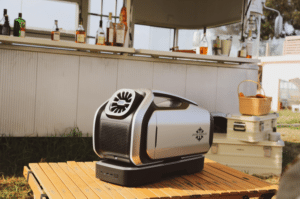
Best Portable Skoolie Air Conditioner
If I really had to choose a portable air conditioner option for a skoolie, I would probably go with a Zero Breeze.
The Zero Breeze is only 240 Watts, so the power draw is minimal – although they are only 2300 BTU.
The price is sort of ridiculous in my opinion since a window air conditioner costs 10% of the price and produces almost double the BTU at the same wattages.
There is an added benefit of having one of these Zero Breeze air conditioners in a skoolie since they do make battery packs for the Zero Breeze units that can run it for up to 3-5 hours.
If you have 2 battery packs, you can run it practically all night. Then charge the batteries during the day off solar. This would probably be the way I would use this unit, then just have a larger air conditioner to run during the day that can better keep up with the hot temperatures.
*This article may contain affiliate links, which means we may receive a commission if you click a link and purchase something we have recommended. Please check our full disclosure policy for more details. Thanks for checking out our website and for your support!








